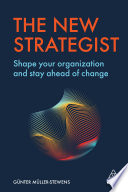

In today's rapidly changing environment, strategic thinking has become crucial for organizations. The book emphasizes the need for leaders to develop a mindset that embraces complexity and uncertainty. This involves understanding the interconnectedness of various factors that influence business decisions, including market trends, consumer behavior, and technological advancements. The author argues that traditional strategic planning methods are often insufficient in addressing the dynamic nature of modern markets. Instead, leaders must cultivate adaptive strategies that allow for flexibility and responsiveness to change. This approach encourages continuous learning and iteration, enabling organizations to pivot quickly in response to new information or shifts in the competitive landscape.
Continue readingInnovation is presented as a key driver of competitive advantage in 'The New Strategist.' The author discusses how organizations must prioritize innovation not just in products and services, but also in processes and business models. The book highlights case studies of companies that have successfully leveraged innovation to transform their strategies and achieve remarkable growth. It stresses the importance of fostering a culture that encourages creativity and risk-taking among employees. By embracing innovation, organizations can differentiate themselves in the marketplace and adapt to changing consumer demands. The author also provides practical frameworks for integrating innovation into strategic planning, ensuring that it remains a core component of the organization's overall strategy.
Continue readingThe book underscores the significance of data in shaping strategic decisions. In an era where information is abundant, leaders are encouraged to harness data analytics to gain insights into market trends and customer preferences. The author argues that data-driven decision-making not only enhances the accuracy of strategic choices but also mitigates risks associated with uncertainty. By utilizing advanced analytics tools, organizations can identify patterns and forecast future developments, allowing them to make informed decisions that align with their strategic objectives. The book also discusses the ethical considerations of data use and the importance of transparency in building trust with stakeholders.
Continue readingResilience and agility are highlighted as essential qualities for organizations facing disruption. The author emphasizes that in a volatile business environment, organizations must be prepared to adapt quickly to unforeseen challenges. This requires a strategic focus on building resilient systems and processes that can withstand shocks and recover rapidly. The book provides insights into how organizations can develop agility by fostering a culture of collaboration, encouraging cross-functional teams, and implementing flexible operational frameworks. By prioritizing resilience and agility, organizations can not only survive crises but also seize opportunities for growth during turbulent times.
Continue readingThe importance of engaging stakeholders in the strategic process is a central theme in 'The New Strategist.' The author argues that successful strategies are not developed in isolation; they require input and collaboration from various stakeholders, including employees, customers, suppliers, and the community. The book discusses techniques for effective stakeholder engagement, such as active listening and co-creation, which can lead to more inclusive and innovative strategies. By fostering strong relationships with stakeholders, organizations can gain valuable insights, enhance their reputation, and build a loyal customer base. The author also highlights the role of corporate social responsibility in strengthening stakeholder relationships and achieving long-term success.
Continue readingDigital transformation is presented as a critical aspect of modern strategy. The book explores how organizations can leverage digital technologies to enhance their operations, improve customer experiences, and drive innovation. The author provides a roadmap for navigating digital transformation, emphasizing the need for a clear vision and a strategic approach to technology adoption. This includes assessing the organization's current capabilities, identifying gaps, and investing in the right tools and talent. The book also addresses the challenges associated with digital transformation, such as resistance to change and the need for continuous learning. By embracing digital transformation, organizations can position themselves for success in an increasingly digital world.
Continue readingThe final key idea revolves around the importance of having a long-term vision and a commitment to sustainability. The author argues that organizations must look beyond short-term gains and prioritize sustainable practices that benefit both the business and society. This includes considering the environmental, social, and economic impacts of strategic decisions. The book emphasizes that a long-term perspective not only enhances organizational resilience but also attracts customers and investors who value sustainability. The author provides examples of companies that have successfully integrated sustainability into their strategies, demonstrating that a commitment to long-term goals can lead to competitive advantages and lasting success.
Continue reading